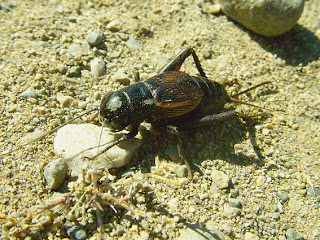I've been making a point of checking out Clover Point just around sunrise every morning this week in the hope of finding a grounded lapland longspur, horned lark or similar.
And every morning I've thus far been unsuccessful.
Despite the lack of enticing off-passage migrants, there's actually been a fair bit of activity on show. Large numbers of common murres and rhinoceros auklets can be seen offshore, and dotted among them there are always a few pigeon guillemots and a handful of marbled murrelets.
The surf scoter flocks continue to build, as do the numbers of harlequin duck along the rocky shoreline. Horned grebes and red-necked grebes are increasing too, and all week there have been up to three western grebes.
Yesterday I happened to take a pic of a pair of distant western grebes as they were elegantly silhouetted by the rising sun. As you can see here, the resulting snap (taken through my 'scope) was pretty terrible.
 |
| Both western grebes? |
The bird on the left appears to have a brighter, slightly upturned bill and it's eye is clearly visible against its white cheek.
The angle isn't great but as I peered at it I couldn't help thinking that there was enough to set small alarm bells tinkling... I just wish I'd noticed at the time!
I expect that this is well within the range of western, but having never seen a Clarke's grebe I thought it might be worth gathering some input from other birders.
Naturally, I have looked for the grebe again but have so far only seen 1 western in the area.
Anyhoo, dodgy dubious grebes aside, other things of note down at Clover Point this week include the arrival of at least 4 common loons, a fly-by mini-skein of 4 greater white-fronted geese and a few more Thayer's gulls joining the larid masses. There are still lots of Heermann's gulls around while California gulls are starting to thin out. Mew gull numbers increase daily.
 |
| Western sandpipers roosting on kelp |
Of the few passerines passing through, savannah sparrow numbers peaked at an unremarkable 8 this morning (Friday), with a few American pipits passing over most days. Good numbers of American robins were on the move on Tuesday and on Thursday 4 Brewer's blackbirds were something of a surprise.
Otherwise, I made a couple of brief stops at Summit Hill reservoir where I saw my first lesser scaup of the autumn. A couple of shoveler remain on the water and the garry oaks continue to attract good numbers of yellow-rumped warblers.
My lunchtime saunters by Langford Lake have turned up a cackling goose, which flew in with some bog-standard Canada geese, a pair of merlin harassing a norther flicker, plus increases in common 'winter' sparrows, yet more YR warblers, ruby-crowned kinglets etc.
One day, as I walked to the lake I stumbled across the impressive fellow in the picture here. I assume it's a field cricket. Very nice!
With a mini-pelagic planned for tomorrow, I hope to see some half-decent seabirds. We're not heading out too far, just to Race Rocks, so there'll be no shearwaters or albatrosses but it'll be interesting to see what we can find.


No comments:
Post a Comment